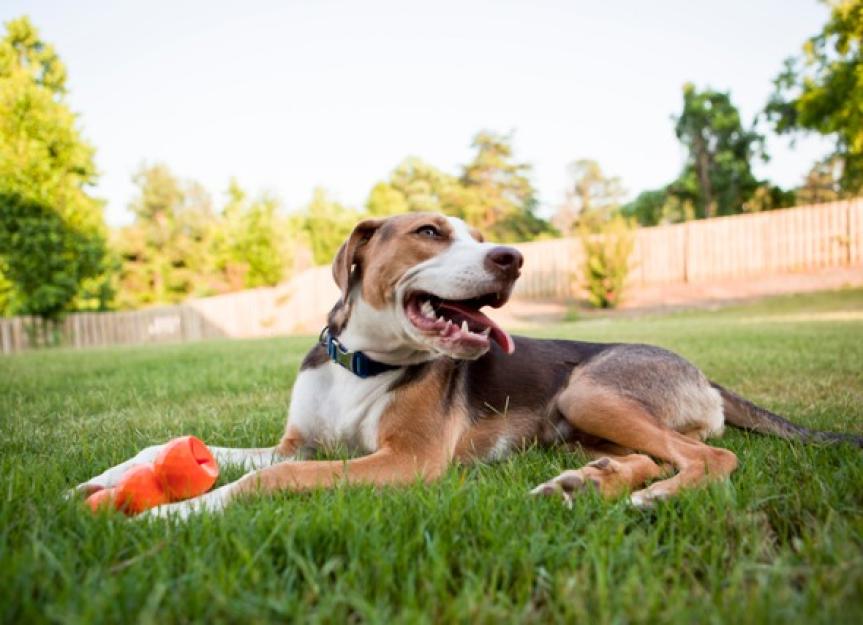How to Get Rid of Fleas in the Yard
Fleas can be a serious problem. They can cause itching and allergic reactions, transmit diseases, and if they’re really severe, cause serious blood loss and illness. You should do your best to keep your pet protected from fleas.
But complete protection against fleas means not only treating your pet but also your home and your yard.
In addition to using a safe and effective flea control product on your pet, do simple things like washing pet bedding, keeping the yard clear, and keeping the grass short to get rid of fleas.
Why Do I Need to Treat My Yard for Fleas?
Protecting your pet from fleas can be challenging, because the adult fleas you see on your pet make up less than 5% of all the fleas in and around your home.
Adult fleas jump onto pets, bite them, and lay eggs, but the rest of theflea’s life cycle, from egg to adult, all happens in your home and yard.
Fleas can survive harsh conditions and find their way into your home and onto your pets. And some pets may not be able to useflea treatmentsdue to allergies to them or other medical issues.
That’s why you need to treat your yard for fleas at the same time as giving your pet flea control. This can help reduce a pet’s exposure to fleas.
Getting Rid of Fleas in Your Yard
While you can’t get rid of all the fleas in your yard, use these tips to help make your yard less attractive and reduce the number of fleas in the yard.
Clear Out the Excess Plants and Overgrowth
Fleas prefer high temperatures and humidity. They also like dark places. Overgrown yards with lots of leaves can be the perfect place for fleas to breed.
You can make your yard a less welcoming place by keeping your yard neat and clean:
Clean up any fallen leaves or debris frequently
Keep the grass short
This makes it harder for fleas to live in your yard.
Avoid Pesticides That Can Harm Pets and Wildlife
While applying treatments or products for flea control in your yard, you don’t want to accidentally poison or kill other animals.
A big concern is bees. Bee populations are rapidly declining, which poses economic and ecological threats. Pesticide use is a factor, and many products commonly marketed and used as flea sprays for yards are highly toxic to bees.
Use Caution With These Yard Flea Control Options
When deciding which products to use to kill fleas in your yard, remember to consider how safe they are for wildlife and pets. Here are some potential flea control options for your yard and what you should keep in mind.
Yard Flea Sprays
Be sure to read the label carefully for any products you’re considering spraying in your yard to know what’s in them and if the active ingredients may be toxic. Always follow package directions carefully, as failure to do so can increase the toxic potential of these chemicals.
Yard flea treatments may be effective, but they could also pose risks to animals and beneficial insects. The ingredient with the fewest side effects is spinosad, which is approved for use in organic farming. It is still very toxic to bees when wet, but once dry, it’s not toxic. It is variably toxic to aquatic animals.
Permethrin, bifenthrin, or any other active ingredient that ends with-thrin(all in this same family of drugs) are very toxic to cats. Sprays that contain these -thrin ingredients, along with fipronil and esfenvalerate, are highly toxic to bees. Another concern is that pesticides sprayed in your yard can end up in rivers and streams, and many are highly toxic to fish and other aquatic animals.
Many yard sprays that are marketed as natural flea control contain essential oils like clove, cinnamon, cedarwood, and lemongrass. While they may be relatively safe, they might not be effective at reducing, repelling, or killing fleas in your yard.
Beneficial Nematodes
If you have to use something, the safest option is beneficial nematodes. These microscopic worms live as parasites on fleas, causing them to die. They live naturally in the dirt, but you can use a sprayer in order to add more to your yard to keep flea populations at bay.
While beneficial nematodes can affect some other ground-dwelling insects, they don’t infect bees or aquatic animals. Beneficial nematode products are available online and from local garden stores.
Boric Acid
Boric acid, also known as borax (found in a product like FleaBusters), is a naturally occurring compound that’s effective for killing fleas and relatively nontoxic to bees and aquatic animals. It can be toxic to plants, so you will need to apply it with caution.
硼酸是一种粉,可以保存权杖ad over affected areas. It can require relatively frequent application.
印楝油
Neem oilfrom the seeds of the neem tree can be effective against fleas; however, it does have variable toxicity for aquatic animals. Typically, it doesn’t have long-lasting effects.
It is available commercially as a pesticide.
Diatomaceous Earth
Diatomaceous earthis effective but must be used carefully.
It’s a fine powder made up of microscopic organisms that physically damage an insect’s exoskeleton. It is recommended for use only at night, on the ground, and in areas away from blooming flowers to reduce bee exposure.
If you use diatomaceous earth, be sure to use one labeled as a pesticide. Only products labeled as pesticides, not as food-grade, have been processed in a way to reduce the risk of inhalation that can damage the lungs. However, be aware that if it gets on bees, it can kill them just as it would fleas.
Featured Image: iStock.com/Marilyn Nieves
Help us make PetMD better
Was this article helpful?
